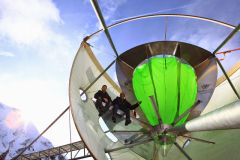
New technology created to produce high-quality snow is being tested in Obergurgl in the Austrian Tirol.
The artificial cloud the machine creates produces low-density snow using considerably less energy and water than traditional snow machines, which its designers hope could potentially revolutionize artificial snow-making.
The new technology, produces "close-to-natural" snow crystals according to its backers, and is much more sustainable than current snow production methods.
The artificial cloud can make up to 15 cubic metres of powder snow, with a low density of 80-220 kg/m³, from only 1 cubic metre of water. The powdery snow will initially be used for specific areas within a skiing resort where high quality snow is important, such as beginner slopes or fun parks.
"From an economic and ecological point of view, the new technology is very interesting as it uses considerably less energy and water," said Michael Bacher, the scientific leader of the project who has been interested in this topic for many years.
Bacher is working with colleagues from the University of Natural Resources and Life Sciences in Vienna and the Vienna University of Technology. They have filed a patent "Dendritic Snow Production" and founded the company "Neuschnee" (fresh snow) this year.
The centre piece of the apparatus is a cloud chamber in which water droplets and ice nuclei are mixed together. Just like in a real cloud low outside temperatures (ideally -5°C) are necessary to produce snow.
Water droplets are sprayed into the cloud chamber, creating a small, artificial cloud. Due to the low temperatures the droplets cool down below 0°C, but don't freeze. Crystallization nuclei (small ice particles) are added to the cloud, which now contains water in three states: frozen, liquid and gaseous. Just like in a real cloud, the ice particles act like magnets and bind the gaseous water molecules, thereby growing to bigger crystals and eventually falling out of the cloud in the form of snow.
As the dimensions of clouds and weather fronts in the atmosphere are much bigger than the artificial cloud in the apparatus, the process of snow crystallization needs to be intensified to produce the necessary amounts of snow. To achieve this, the density of particles in the artificial cloud is twice as big as in natural clouds.
The amount of snow produced also depends on other factors, such as wind and temperature, all of which will be tested over the next months in Obergurgl.
"The knowledge we gain by testing the cloud might allow us to use the first cloud operationally next season – in Obergurgl of course," said Bacher.
The machine's cover was created by the designer Walter Klasz of the Institute for Structure and Design at the University of Innsbruck. Klasz and his students have also designed additional applications of the technology, such as a "snow printer". Their ideas are presented in an exhibit at the University Centre Obergurgl.
The technology, which is located near the Hohe-Mut gondola, will be tested throughout this winter season before being hopefully introduced on a large scale.
The artificial cloud was presented for the first time during the TMI (Tourism Meets Industry) event in Seefeld in October. Economy and tourism representatives then saw the cloud in operation and discussed future snow production and piste management during the "Fresh Snow Symposium" at the University Centre Obergurgl. "This project is very important for Tirol. We support the idea and want the company to be successful", says Harald Gohm, managing director of the Agency of Economy and Science Tirol.
